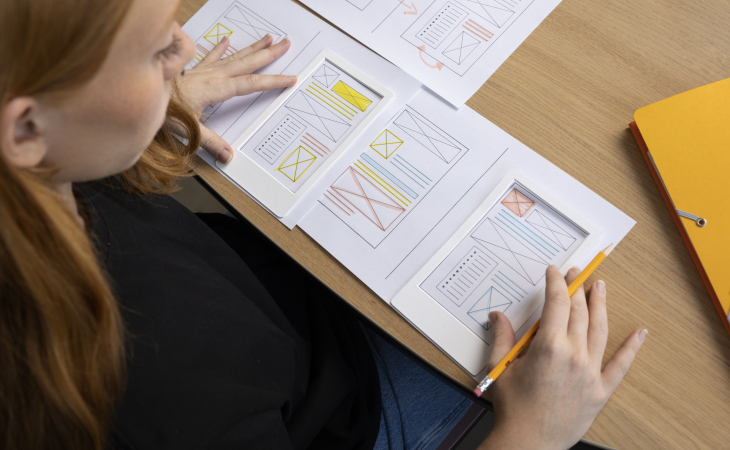UX Design: Everything you need to know
Share

Welcome to the fascinating world ofUX Design, an area where creativity meets functionality to create memorable user experiences. If you're looking to understand the intricacies of UX Design, you've come to the right place. In this article, we will explore together, in a simple and intuitive way, everything you need to know about UX Design.
We'll cover the fundamentals, key processes, and best practices that shape exceptional user experiences. Whether you're new to it or want to expand your knowledge, this article will guide you through the nuances of this essential discipline in the world of design.
We firmly believe in the power of UX Design to transform digital interactions into fluid and enjoyable journeys. Follow us in this introductory article, which serves as a prelude to a more detailed exploration of UX Design, and discover how this expertise can enrich your projects and careers in the digital world.
What is UX Design? (definition, 3 pillars…)
Are you wondering what exactly UX Design is? UX Design, or user experience design, is a user-centered approach to creating products that deliver meaningful and relevant experiences to users. It revolves around understanding user needs, expectations and behaviors to design solutions that not only meet their expectations but also exceed them.
The 3 pillars of UX Design
Usability
Usability is the ease with which users can interact with a product. A successful design is intuitive, easy to use, and allows users to achieve their goals without friction.
accessibility
Accessibility is essential to ensure that all users, including those with disabilities, can access and use products. This means creating designs that are understandable and usable by everyone, regardless of their situation.
emotion
The emotional aspect of UX Design focuses on creating a positive connection between the user and the product. It’s about eliciting positive reactions and emotions, thereby contributing to a memorable and engaging user experience.
We believe that mastering these three pillars is fundamental for any designer wanting to create exceptional user experiences. By focusing on usability, accessibility, and emotion, you can design products that not only meet user needs but also delight them.
What are the differences between UX Design and UI Design?
Are you wondering about the distinction between UX (User Experience) and UI (User Interface) Design? You are not alone. UX Design concerns the overall user experience with a product or service, while UI Design focuses on the visual and interactive aspects of the user interface.
In other words, theUX Design just like the Design Thinking is focused on the entire user journey, seeking to optimize overall satisfaction by making the user experience intuitive, engaging and efficient. It encompasses the structure, process and overall interaction with the product.
Conversely, theUI Design is the aesthetic and interactive touch of the product. It focuses on buttons, icons, spacing, typography and all visual elements, ensuring that the interface is not only attractive but also functional and consistent.
We believe that the distinction between UX and UI is crucial to creating successful digital products. UX design without solid UI design can lead to a functional but unengaging user experience. Likewise, a beautiful UI design without a solid UX foundation can be aesthetically pleasing but difficult to use. The key is to find the perfect balance between the two to create seamless and engaging experiences for users.
What training for UX Design?
If you aspire to excel in UX Design, choosing the right training is crucial. Intuit Lab offers design programs that cover UX Design in depth, providing students with the skills and understanding to excel in this field.
Intuit Lab's UX Design courses focus on practical and theoretical methodologies, teaching how to create user experiences that are both intuitive and rewarding. Students learn through a series of hands-on workshops, real-world projects and constructive feedback, allowing them to gain valuable experience before even entering the professional world.
We believe that the UX Design training offered by Intuit Lab is ideal for those looking to understand the fundamentals of user experience while developing a practical, user-centered approach. By enrolling in Intuit Lab, you embark on an educational journey that combines creativity, innovation and a solid understanding of UX Design, preparing you to meet the design challenges of tomorrow.
How much can you earn as a UX Designer?
In France, the salary of a UX Designer can vary depending on many criteria, such as experience, location, or even the size of the company. For a beginner, salary can usually start around 30 000 € per year. With experience, specialized skills and a role in a large company or a metropolis like Paris, a UX Designer can see their salary rise up to 70 000 € or more for very experienced profiles and high-level positions.
It is important to emphasize that these figures may fluctuate depending on the specifics of the market and the evolution of demand for UX Design skills. We encourage UX Designers to continually educate themselves and stay informed of market trends to optimize their compensation prospects in this dynamic and ever-changing field.
Is UX Design important for SEO?
Wondering if UX Design plays a role in SEO? The answer is a Yes resounding. UX Design and SEO are intrinsically linked, as the user experience on a website directly influences its ranking in search engines. Google.
Quality UX Design ensures that visitors find what they are looking for quickly and easily, which reduces bounce rates and increases time on site – two key indicators for SEO. Additionally, a well-designed site is also more likely to encourage shares and backlinks, improving its visibility and authority online.
We are convinced that investing in quality UX Design is also an investment in your SEO strategy. An intuitive, accessible and pleasant to use site is not only beneficial for the user but also for your positioning in search engines. By integrating UX Design into your SEO strategy, you promote a positive user experience which is rewarded with better online visibility.

